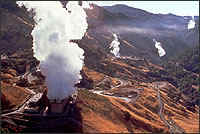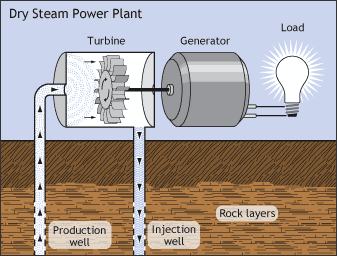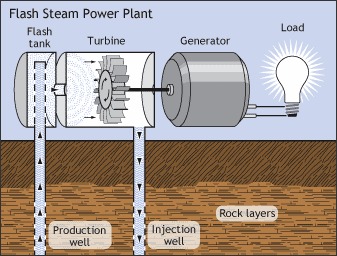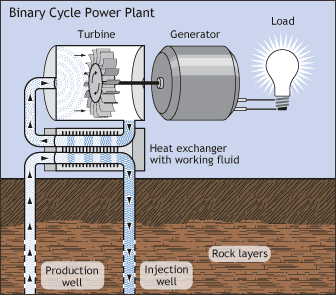|
Geothermal Power Plant
www.GeothermalPowerPlant.com
Advertising with us
produces results!
Increased
sales
New customers
Greater market share
Competitive advantage
Increased shareholder value
For Geothermal Power Plant; Advertising, Business Development,
Marketing, or Sales solutions, call or email:

Austin, Texas
marketing@GeothermalPowerPlant.com
"The
Future of Energy is Net Zero
Energy!"
and
Way Beyond Solar! sm
"Net Zero Energy"
to Reach Revenues of $690 Billion / year by 2020
and $1.3 Trillion / year Industry by 2035
Thanks electric utilities and electric grid,
we'll take it from here!
|
Geothermal Power Plant
www.GeothermalPowerPlant.com
What
is a Geothermal Power Plant?
A geothermal power plant captures and uses the heat from the
earth to drive one or more steam turbines
that turn one or more synchronous
generators, which generate "carbon
free energy," "pollution
free power" and "zero
emission power."
There
are three geothermal power plant technologies being used to convert hydrothermal
fluids to electricity. The conversion technologies are dry steam, flash, and
binary cycle. The type of conversion used depends on the state of the fluid
(whether steam or water) and its temperature. Dry steam power plants systems
were the first type of geothermal power generation plants built. They use the
steam from the geothermal reservoir as it comes from wells, and route it
directly through turbine/generator units to produce electricity. Flash steam
plants are the most common type of geothermal power generation plants in
operation today. They use water at temperatures greater than 360°F (182°C)
that is pumped under high pressure to the generation equipment at the surface.
Binary cycle geothermal power generation plants differ from Dry Steam and Flash
Steam systems in that the water or steam from the geothermal reservoir never
comes in contact with the turbine/generator units.

Renewable Energy
Institute
"Changing the Way the
World Makes and Uses Energy!"

Austin, Texas
marketing@GeothermalPowerPlant.com
What
is the Organic Rankine Cycle?
An
Organic
Rankine Cycle uses a heated chemical instead of steam as found in the
Rankine Cycle. Chemicals
used in the Organic
Rankine Cycle include freon, butane,
propane, ammonia, and the new environmentally-friendly" refrigerants.
A Rankine
cycle is a closed circuit steam
cycle. (see www.RankineCycle.com
for more information).
Why
use a chemical refrigerant?
A refrigerant boils at a temperature below the temperature of frozen ice. Solar
heat, for example, of only 150 degrees Fahrenheit from a typical rooftop solar
hot water heater, will furiously boil a refrigerant. The resulting high-pressure
refrigerant vapor is then piped to an organic Rankine
cycle engine.
Why is it called "organic"?
"Organic" is a term used in chemistry to describe a class of chemicals
that includes Freon and most of the other common refrigerants.
Types of Geothermal Power Plants
Dry Steam Power Plants

Dry
steam power plants at the Geysers in California.
Steam plants use hydrothermal fluids that are primarily steam. The steam goes
directly to a turbine, which drives a generator that produces electricity. The
steam eliminates the need to burn fossil fuels to run the turbine. (Also
eliminating the need to transport and store fuels!) This is the oldest type of
geothermal power plant. It was first used at Lardarello in Italy in 1904, and is
still very effective. Steam technology is used today at The Geysers in northern
California, the world's largest single source of geothermal power. These plants
emit only excess steam and very minor amounts of gases.

Dry Steam Power Plant
Flash
Steam Power Plants
Hydrothermal
fluids above 360°F (182°C) can be used in flash plants to make electricity.
Fluid is sprayed into a tank held at a much lower pressure than the fluid,
causing some of the fluid to rapidly vaporize, or "flash." The vapor
then drives a turbine, which drives a generator. If any liquid remains in the
tank, it can be flashed again in a second tank to extract even more energy.

Flash Steam Power Plant
Binary-Cycle
Power Plants
Most
geothermal areas contain moderate-temperature water (below 400°F). Energy is
extracted from these fluids in binary-cycle power plants. Hot geothermal fluid
and a secondary (hence, "binary") fluid with a much lower boiling
point than water pass through a heat exchanger. Heat from the geothermal fluid
causes the secondary fluid to flash to vapor, which then drives the turbines.
Because this is a closed-loop system, virtually nothing is emitted to the
atmosphere. Moderate-temperature water is by far the more common geothermal
resource, and most geothermal power plants in the future will be binary-cycle
plants.

Binary
Cycle Power Plant
The Future of Geothermal Electricity
Steam
and hot water reservoirs are just a small part of the geothermal resource. The
Earth's magma and hot dry rock will provide cheap, clean, and almost unlimited
energy as soon as we develop the technology to use them. In the meantime,
because they're so abundant, moderate-temperature sites running binary-cycle
power plants will be the most common electricity producers.
Before
geothermal electricity can be considered a key element of the U.S. energy
infrastructure, it must become cost-competitive with traditional forms of
energy. The U.S. Department of Energy is working with the geothermal industry to
achieve $0.03 to $0.05 per kilowatt-hour. We believe the result will be about
15,000 megawatts of new capacity within the next decade.
Some
of the above information provided with our thanks by the Department of Energy.
What
is Geothermal
Heating and Cooling?
Geothermal heating
and cooling is the technology that uses the free and available heat
from the earth to provide heating and/or cooling for a home, business, industry
or industrial process.
What
is a Geothermal Heat Pump?
Geothermal
heat pumps, also known as the ground
source heat pumps, are highly efficient renewable
energy technologies that is gaining wide acceptance for both residential and
commercial buildings.
Geothermal
heat pumps are used for space heating and cooling, as well as water heating.
Its great advantage is that it works by concentrating naturally existing heat,
rather than by producing heat through combustion of fossil fuels.
The
technology relies on the fact that the Earth (beneath the surface) remains at a
relatively constant temperature throughout the year, warmer than the air above
it during the winter and cooler in the summer - very similar to a cave.
The
geothermal heat pump takes advantage of this by transferring heat stored in the
Earth or in ground water into a building during the winter, and transferring it
out of the building and back into the ground during the summer. The ground acts
as a "heat source" in winter and a "heat sink" in summer.
The
system includes three principal components:
-
Geothermal
earth connection subsystem
-
Geothermal
heat pump subsystem
-
Geothermal
heat distribution subsystem.
Another
term used to describe homes and buildings using geothermal
heat pumps is that they are "Earth
coupled" in that they are using the Earth as a heat source (in winter)
and a heat sink in the summer. The Earth
coupled system uses a series of pipes, commonly called a "loop"
which is buried in the ground near the building to be heated or cooled.
The loop can be buried either vertically or horizontally. It circulates a fluid
(water, or a mixture of water and antifreeze) that absorbs heat from, or gives
heat to, the surrounding soil, depending on whether the ambient air is colder or
warmer than the soil.
Heat
Pump Subsystem
For
heating, a geothermal heat pump removes the heat from the fluid in the Earth
connection, concentrates it, and then transfers it to the building. For cooling,
the process is reversed.
Heat
Distribution Subsystem
Conventional
ductwork is generally used to distribute heated or cooled air from the
geothermal heat pump throughout the building.
Residential
Hot Water
In
addition to space conditioning, geothermal heat pumps can be used to provide
domestic hot water when the system is operating. Many residential systems are
now equipped with desuperheaters that transfer excess heat from the geothermal
heat pump's compressor to the house's hot water tank. A desuperheater provides
no hot water during the spring and fall when the geothermal heat pump system is
not operating; however, because the geothermal heat pump is so much more
efficient than other means of water heating, manufacturers are beginning to
offer "full demand" systems that use a separate heat exchanger to meet
all of a household's hot water needs. These units cost-effectively provide hot
water as quickly as any competing system.
What
is Renewable
Heating and Cooling?
Renewable
heating and cooling is the technology that uses one of the free or
nearly-free renewable energy resources, such as geothermal, solar or biomass,
for the generation of heating and/or cooling for a home, business, industry or
industrial process.

Renewable Energy
Institute
"Changing the Way the
World Makes and Uses Energy!"

Austin, Texas
marketing@GeothermalPowerPlant.com
Engineering and
Project Development Services
Absorption
Chillers
* Adsorption
Chillers *
Ammonia
Chillers *
Brayton
Cycle * Carbon
Emissions
Carnot
Cycle *
Cheng
Cycle *
CHP
Systems
* Clean
Power Generation * Cogeneration
Compressed
Air Energy Storage * Concentrating
Solar Power * EcoGeneration
* Emissions Abatement
Engine
Driven Chillers * Graz
Cycle * Inlet
Cooling * Mechanical
Refrigeration * Organic
Rankine Cycle
Rankine
Cycle * Recycled
Energy * Solar
Cogeneration * Trigeneration
* Waste
Heat Recovery
The Graz Cycle
is also known as the "Zero
Emission Power Plant!"
Greenhouse
Gas Reporting services now available
Net
Zero Energy Buildings Are Next Frontier
http://www.sustainablebusiness.com/index.cfm/go/news.display/id/23361
Net
Zero Energy Market to Become $1.3 Trillion/year Industry by 2035
http://www.navigantresearch.com/newsroom/revenue-from-net-zero-energy-buildings-to-reach-1-3-trillion-by-2035
Net Zero Energy Buildings Are Coming - What About The Buildings Already
Standing?
http://www.forbes.com/sites/justingerdes/2012/02/28/net-zero-energy-buildings-are-coming-what-about-the-buildings-already-standing/
American
Energy Plan sm
www.AmericanEnergyPlan.org
3-5
million new jobs
Fuel Savings of > $1.50/gallon
American Energy Independence
Ends the worst economic depression of all time

NO
FOREIGN OIL!
www.NoForeignOil.com
Support
Renewable Energy
and America's
Renewable Energy Technologies
resources and companies!
“spending
hundreds and hundreds and hundreds of billions of dollars every year for oil,
much of it from the Middle East, is just about the single stupidest thing that
modern society could possibly do. It’s very difficult to think of anything
more idiotic than that.”
~ R. James Woolsey, Jr., former
Director of the CIA
According to R. James Woolsey, for Director of the Central Intelligence Agency, “The basic insight is to realize that global warming, the geopolitics of oil, and warfare in the Persian Gulf are not separate problems — they are aspects of a single problem, the West’s dependence on oil."
Architects * Free
Power and Energy * Geothermal Heating and Cooling *
Net Zero Energy Retrofits
Real Estate Master
Planning * Solar Cogeneration * Solar Heating and
Cooling * Solar Trigeneration
We
support the Renewable Energy
Institute and the American
Energy Plan by donating a portion of our profits to the
Renewable Energy
Institute in their efforts to reduce fossil fuel use through
renewable energy and their goals to end fossil fuel pollution by
reducing/eliminating Carbon Emissions,
Carbon Dioxide Emissions and
Greenhouse Gas Emissions.
The
Renewable Energy
Institute
is "Changing The Way The World Makes
and Uses Energy by
Providing Research & Development, Funding and Resources That Creates
Sustainable Energy via 'Carbon Free
Energy,' 'Clean
Power Generation' and 'Pollution Free
Power' Through
Expanding the use of Renewable Energy
Technologies."
Follow us on Twitter:


The information contained on this site is
copyright protected and
cannot be
reproduced in any form or manner without our consent.
Geothermal Power Plant
www.GeothermalPowerPlant.com

Austin, Texas
marketing@GeothermalPowerPlant.com
Renewable
Energy Institute
GeothermalPowerPlant.com
© Copyright 2003
All Rights Reserved






